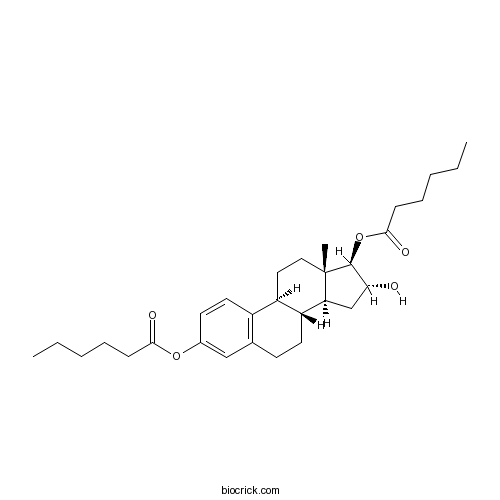Estriol 3,17-dihexanoateCAS# 104202-96-2 |

Quality Control & MSDS
3D structure
Package In Stock
Number of papers citing our products

| Cas No. | 104202-96-2 | SDF | Download SDF |
| PubChem ID | 128509 | Appearance | Powder |
| Formula | C30H44O5 | M.Wt | 484.7 |
| Type of Compound | Steroids | Storage | Desiccate at -20°C |
| Solubility | Soluble in Chloroform,Dichloromethane,Ethyl Acetate,DMSO,Acetone,etc. | ||
| Chemical Name | [(8R,9S,13S,14S,16R,17R)-3-hexanoyloxy-16-hydroxy-13-methyl-6,7,8,9,11,12,14,15,16,17-decahydrocyclopenta[a]phenanthren-17-yl] hexanoate | ||
| SMILES | CCCCCC(=O)OC1C(CC2C1(CCC3C2CCC4=C3C=CC(=C4)OC(=O)CCCCC)C)O | ||
| Standard InChIKey | ZOVABFBGAYSQTL-AECPDVIXSA-N | ||
| Standard InChI | InChI=1S/C30H44O5/c1-4-6-8-10-27(32)34-21-13-15-22-20(18-21)12-14-24-23(22)16-17-30(3)25(24)19-26(31)29(30)35-28(33)11-9-7-5-2/h13,15,18,23-26,29,31H,4-12,14,16-17,19H2,1-3H3/t23-,24-,25+,26-,29+,30+/m1/s1 | ||
| General tips | For obtaining a higher solubility , please warm the tube at 37 ℃ and shake it in the ultrasonic bath for a while.Stock solution can be stored below -20℃ for several months. We recommend that you prepare and use the solution on the same day. However, if the test schedule requires, the stock solutions can be prepared in advance, and the stock solution must be sealed and stored below -20℃. In general, the stock solution can be kept for several months. Before use, we recommend that you leave the vial at room temperature for at least an hour before opening it. |
||
| About Packaging | 1. The packaging of the product may be reversed during transportation, cause the high purity compounds to adhere to the neck or cap of the vial.Take the vail out of its packaging and shake gently until the compounds fall to the bottom of the vial. 2. For liquid products, please centrifuge at 500xg to gather the liquid to the bottom of the vial. 3. Try to avoid loss or contamination during the experiment. |
||
| Shipping Condition | Packaging according to customer requirements(5mg, 10mg, 20mg and more). Ship via FedEx, DHL, UPS, EMS or other couriers with RT, or blue ice upon request. | ||

Estriol 3,17-dihexanoate Dilution Calculator

Estriol 3,17-dihexanoate Molarity Calculator
| 1 mg | 5 mg | 10 mg | 20 mg | 25 mg | |
| 1 mM | 2.0631 mL | 10.3157 mL | 20.6313 mL | 41.2626 mL | 51.5783 mL |
| 5 mM | 0.4126 mL | 2.0631 mL | 4.1263 mL | 8.2525 mL | 10.3157 mL |
| 10 mM | 0.2063 mL | 1.0316 mL | 2.0631 mL | 4.1263 mL | 5.1578 mL |
| 50 mM | 0.0413 mL | 0.2063 mL | 0.4126 mL | 0.8253 mL | 1.0316 mL |
| 100 mM | 0.0206 mL | 0.1032 mL | 0.2063 mL | 0.4126 mL | 0.5158 mL |
| * Note: If you are in the process of experiment, it's necessary to make the dilution ratios of the samples. The dilution data above is only for reference. Normally, it's can get a better solubility within lower of Concentrations. | |||||

Calcutta University

University of Minnesota

University of Maryland School of Medicine

University of Illinois at Chicago

The Ohio State University

University of Zurich

Harvard University

Colorado State University

Auburn University

Yale University

Worcester Polytechnic Institute

Washington State University

Stanford University

University of Leipzig

Universidade da Beira Interior

The Institute of Cancer Research

Heidelberg University

University of Amsterdam

University of Auckland

TsingHua University

The University of Michigan

Miami University

DRURY University

Jilin University

Fudan University

Wuhan University

Sun Yat-sen University

Universite de Paris

Deemed University

Auckland University

The University of Tokyo

Korea University
- 10-Nitro-camptothecin
Catalog No.:BCN2581
CAS No.:104195-61-1
- Stanozolol
Catalog No.:BCC9154
CAS No.:10418-03-8
- Alpinoid D
Catalog No.:BCN3593
CAS No.:1041740-13-9
- MitoPY1
Catalog No.:BCC6177
CAS No.:1041634-69-8
- Kuguaglycoside C
Catalog No.:BCN3276
CAS No.:1041631-93-9
- Peramivir Trihydrate
Catalog No.:BCC4956
CAS No.:1041434-82-5
- Eldecalcitol
Catalog No.:BCC1548
CAS No.:104121-92-8
- Phellodendrine chloride
Catalog No.:BCN5934
CAS No.:104112-82-5
- Kadsuric acid 3-methylester
Catalog No.:BCN3186
CAS No.:1041070-16-9
- SR 95531 hydrobromide
Catalog No.:BCC6997
CAS No.:104104-50-9
- Fmoc-D-Glu(OtBu)-OH
Catalog No.:BCC3496
CAS No.:104091-08-9
- Zolantidine dimaleate
Catalog No.:BCC6922
CAS No.:104076-39-3
- Yunnandaphninine G
Catalog No.:BCN5857
CAS No.:1042143-83-8
- IRAK inhibitor 1
Catalog No.:BCC1654
CAS No.:1042224-63-4
- Famciclovir
Catalog No.:BCC4780
CAS No.:104227-87-4
- IRAK inhibitor 6
Catalog No.:BCC1658
CAS No.:1042672-97-8
- Bisoprolol fumarate
Catalog No.:BCC4344
CAS No.:104344-23-2
- Tetrahydroxysqualene
Catalog No.:BCN5858
CAS No.:1043629-23-7
- RU-SKI 43
Catalog No.:BCC5441
CAS No.:1043797-53-0
- L803-mts
Catalog No.:BCC5889
CAS No.:1043881-55-5
- Typhaneoside
Catalog No.:BCN4994
CAS No.:104472-68-6
- 3'-Methylflavokawin
Catalog No.:BCN3990
CAS No.:1044743-35-2
- RVX-208
Catalog No.:BCC4475
CAS No.:1044870-39-4
- Testosterone acetate
Catalog No.:BCC9165
CAS No.:1045-69-8
Plasma estriol levels after intramuscular injection of estriol and two of its esters.[Pubmed:1819548]
Horm Res. 1991;35(6):234-8.
Twelve female volunteers from Berlin and 9 from Stockholm, all using a contraceptive pill (30 micrograms ethinyl estradiol and 150 micrograms levonorgestrel), received an intramuscular injection of estriol (E3; 1 mg in oil) on day 5 of withdrawal bleeding. Blood samples were collected at increasing time intervals during 4 weeks. Three months later, on day 5 of their withdrawal bleeding, 6 women were given intramuscularly (in oil) estriol 3,17-dipropionate (E3-prop) and 15 women Estriol 3,17-dihexanoate (E3-hex). The doses were equivalent to 5 mg of estriol, i.e. 6.94 and 8.90 mg, respectively. Blood samples were collected during a period of 9 weeks. Estriol was analyzed by radioimmunoassay in all plasma samples. The average half-life of E3 ranged from 1.5 to 5.3 h after the administration of E3. It was 12.7 h and between 187 and 221 h after the administration of E3-prop and E3-hex, respectively. The average areas under the curve (in nmol.l-1.h) of E3 were between 82.5 and 161 after the administration of E3-prop or E3-hex, and between 27.1 and 37.9 when E3 had been given. As E3 was administered in a 5-fold lower dose than the esters, the areas under curve appeared to be comparable. Thus, the total exposure to E3 seemed to be almost independent of the type of E3 derivatization, while the time and intensity of exposure were very different.


